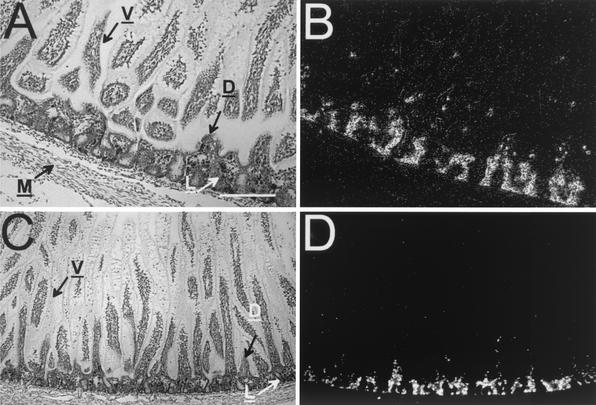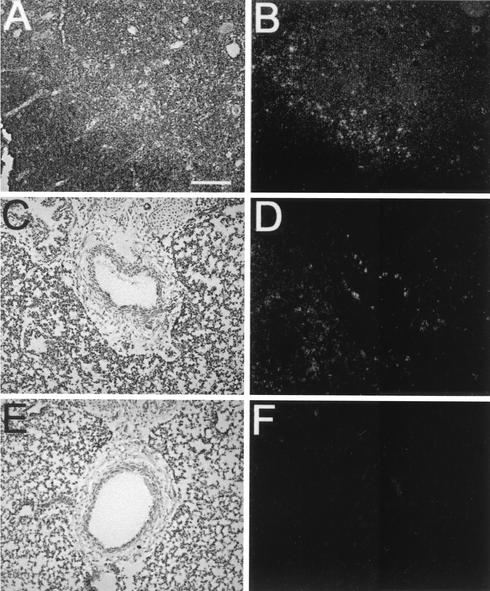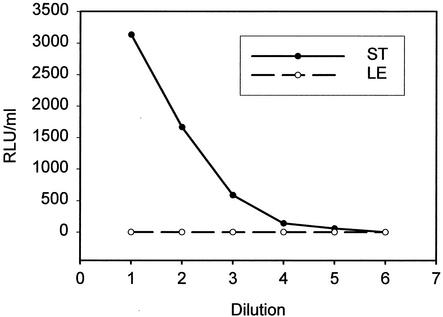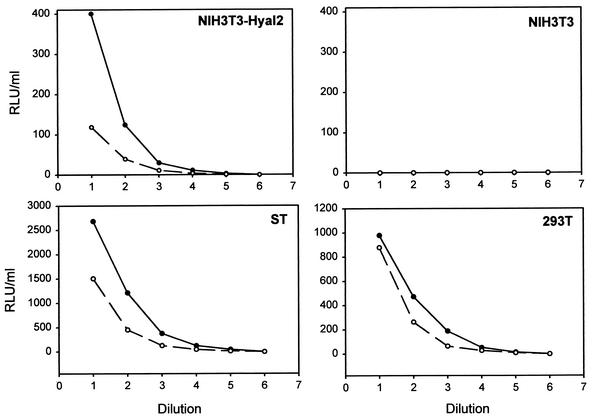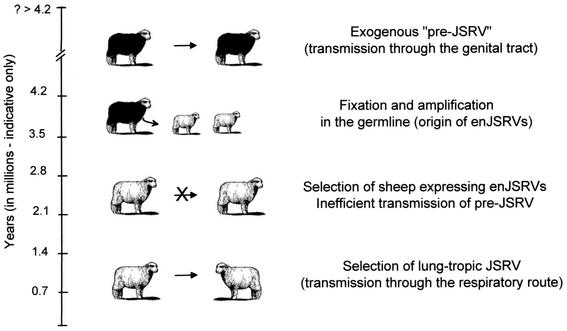Abstract
Betaretroviruses of sheep include two exogenous viruses, Jaagsiekte sheep retrovirus (JSRV) and enzootic nasal tumor virus (ENTV), and a group of endogenous viruses known as enJSRVs. The exogenous JSRV and ENTV are the etiological agents of ovine pulmonary adenocarcinoma (OPA) and enzootic nasal tumor (ENT), respectively. Sheep affected by OPA or ENT do not show an appreciable antibody response to JSRV or ENTV. Consequently, it is conceivable that enJSRV expression in the fetal lamb tolerizes sheep to the related exogenous viruses. In this study, possible mechanisms of interference between the sheep exogenous and endogenous betaretroviruses were investigated. In situ hybridization detected enJSRV RNAs in lymphoid cells associated with the lamina propria of the small intestine and in the thymus of sheep fetuses. Low-level expression of enJSRVs was also detected in the lungs. In addition, expression of enJSRVs was found to block entry of the exogenous JSRV, presumably via mechanisms of receptor interference. Indeed, enJSRVs, like JSRV and ENTV, were found to utilize hyaluronidase-2 as a cellular receptor.
The ability of retroviruses to integrate in the host cell genome has provided a means for these viruses to colonize during the evolution of the genome of virtually all vertebrates. Consequently, retroviruses are transmitted horizontally as “exogenous” viruses or vertically as “endogenous” viruses (28). The majority of endogenous retroviruses have accumulated deletions and/or mutations that render them inactive. However, some endogenous retroviruses are transcriptionally active, and both detrimental and beneficial effects to the host have been hypothesized and, more rarely, substantiated (2-4, 14, 15).
Several exogenous retroviruses have endogenous counterparts. For example, feline leukemia virus in cats, mouse mammary tumor virus and murine leukemia viruses (MLVs) in mice, and avian leukemia viruses in chickens have endogenous counterparts in the germ line of their host species (4).
The exogenous sheep betaretroviruses, Jaagsiekte sheep retrovirus (JSRV) and enzootic nasal tumor virus (ENTV), are pathogenic viruses that cause neoplasms in the respiratory tract of small ruminants (8, 18, 19). JSRV induces ovine pulmonary adenocarcinoma (OPA), a contagious lung tumor of sheep originating from the differentiated epithelial cells of the distal tract of the lung (23). ENTV causes the enzootic nasal tumor of sheep and goats, wherein the tumor originates from the olfactory mucosa of the nasal or ethmoid turbinates (5-7).
Fifteen to 20 copies of endogenous elements related to JSRV and ENTV (enJSRVs) are present in the genome of sheep, goats, and most wild members of the Ovis and Capra genera (11, 12, 29). Interestingly, enJSRVs are highly expressed along the epithelium of the genital tract of the ewe and, in particular, in the luminal and glandular epithelia of the endometrium of the uterus (20, 21, 26). The fixation of these elements in the ovine and caprine genome, combined with their high levels of expression, suggest that these elements had some beneficial effect for their host. Sheep and goats affected by OPA or ENT do not show an appreciable antibody response to JSRV or ENTV (16, 25, 27).
The present study was conducted (i) to understand why sheep and goats affected by OPA or ENT lack an immune response to the exogenous JSRV and ENTV and (ii) to investigate possible mechanisms of interference that have influenced the evolution of ovine betaretroviruses.
enJSRVs are highly related to the exogenous betaretroviruses. The three enJSRV loci that have been completely sequenced are, at the amino acid level, 94 to 95% identical to JSRV21 in Gag, 95 to 99% identical in Pro, 98% identical in Pol, and 92% identical in Env. This high degree of identity suggests that, if the enJSRVs were expressed in the fetus, they would be recognized as self by the host immune system, thereby tolerizing sheep to subsequent infections by JSRV or ENTV.
In situ hybridization was conducted to determine the presence of enJSRV RNA expression in tissues collected from gestation day 120 to 125 fetal lambs. As described previously (26), we used the enJSRV env probe DD54. This probe contains 436 bp of the env gene, which is 96 to 98% identical to enJS56A1 and enJS5F16 clones (21). The small intestine, fetal thymus, and lungs were analyzed. The thymus and lymphoid tissues associated with the small intestine were used because they are instrumental for the development of the sheep immune system (10). The lungs are the primary site of replication of exogenous JSRV (17). A clear positive signal was observed in lymphoid cells of the lamina propria of the gut in correspondence to the jejunal (Fig. 1A and B) and ileal (Fig. 1C and D) Peyer's patches. Signals above background were also observed in the thymus, where enJSRV expression appears in the medulla and in the bronchial epithelial cells of the lungs (Fig. 2). Of particular interest is that expression of enJSRVs in the thymus is found predominantly in the cortico-medullary junction. This may be significant, since it is thought that the final selection of T cells occurs in this region of the thymus (10). These results support the hypothesis that enJSRV basal expression in the fetus might tolerize sheep to the related exogenous betaretroviruses. How the induction of tolerance to an exogenous retrovirus might be beneficial for its host is not immediately apparent (see below).
FIG. 1.
In situ hybridization analysis of enJSRV mRNA expression in Peyer's patch tissue collected from the small intestine of fetal lambs (gestation day 120). Cross sections of different regions of the small intestine from sheep fetuses were hybridized with α-35S-labeled antisense ovine enJSRV cRNA probes. Protected transcripts were visualized by liquid emulsion autoradiography for 1 week and imaged under bright-field or dark-field illumination. (A) Bright field of jejunal Peyer's patch tissue stained with hematoxylin. Numerous lymphoid aggregates (L) are visible between the muscolaris externa (M) and the overlying mucosal epithelium (V). Domes (D) are also visible. (B) In situ hybridization reveals a high degree of enJSRV expression that localizes to cells within the lymphoid aggregates of the jejunal Peyer's patches. (C) Bright field of ileal Peyer's patch tissue stained with hematoxylin. Small lymphoid aggregates are visible between the muscularis externa (M) and the overlying mucosal epithelium (V). (D) In situ hybridization reveals enJSRV RNA expression that is localized to cells within the lymphoid aggregates of the Peyer's patch. Bar, 150 μm.
FIG. 2.
In situ hybridization analysis of enJSRV mRNA expression in the fetal thymus and lung. Cross sections of the thymus (A and B) and lung (C to F) from sheep fetuses were hybridized with α-35S-labeled antisense (A to D) or sense (E and F) ovine enJSRV cRNA probes. Protected transcripts were visualized by liquid emulsion autoradiography for 1 week and imaged under bright-field or dark-field illumination. Signals above background for enJSRVs were localized in the medulla of the thymus (B) and in the bronchiolar epithelium of the lungs (D). Bar, 75 μm.
In order to further investigate other possible interactions between the endogenous and the exogenous betaretroviruses, a study was conducted to determine whether enJSRV expression would interfere with JSRV entry. JSRV entry assays were performed in a cell line derived from the endometrial luminal epithelium of the uterus (LE), where enJSRVs are highly expressed, and in a cell line expressed from the uterine stroma (ST), in which no enJSRV expression is observed (13). For the JSRV entry assays, retroviral vectors pseudotyped with the JSRV envelope and expressing a marker gene (either luciferase or alkaline phosphatase) were utilized. The JSRV-luciferase vector gave values barely above background in LE cells, whereas values around 3,000 relative light units/ml were observed in ST cells (Fig. 3). This study was also repeated with a more sensitive JSRV-alkaline phosphatase vector, and similar results were obtained (data not shown). These experiments suggest that enJSRV expression can block JSRV entry. However, the results obtained might also reflect a differential expression of the JSRV receptor in LE versus ST cells. To experimentally address this point, we derived an ST cell line stably expressing the enJS56A1 envelope (ST-enJE). ST-enJE cells were obtained by using an MLV-based retroviral vector (pLNCX2; Clontech) expressing the env gene of enJS56A1 (21). Control ST cells (ST-control) were obtained as described above but using the empty pLNCX2 vector. In entry assays, ST and ST-control cells were 300 to 360 times more infectible by a JSRV-alkaline phosphatase vector than ST-enJE cells. These results strongly suggest that expression of enJSRV env interferes with JSRV entry, presumably by receptor interference mechanisms.
FIG. 3.
Entry assays employing MLV-luciferase vectors pseudotyped with the JSRV Env. Values are expressed in relative light units; threefold dilutions were used in this experiment. The values are averages of duplicate experiments for each dilution. The figure shows the vector entering ST cells, while values only barely above background were found in LE cells. The experiment was repeated twice with a different DNA plasmid preparation and gave essentially the same results (data not shown).
The receptor for exogenous JSRV and ENTV is hyaluronidase-2 (Hyal-2) (1, 9, 24), a gene expressed in many different cell types. No evidence that Hyal-2 is a receptor for the enJSRV loci is available. In order to test if Hyal-2 is also the receptor for the endogenous betaretroviruses, viral entry assays were performed in mouse NIH 3T3 and NIH 3T3-Hyal2 cells. Rodent cells do not express a functional receptor for the exogenous JSRV and ENTV. NIH 3T3-Hyal2 cells (1, 22) overexpress human Hyal-2. Entry assays were performed using MLV-based retroviral vectors expressing the luciferase gene and pseudotyped with the envelope gene of a previously cloned enJSRV provirus (21). An equivalent vector pseudotyped by the JSRV envelope was used as positive control. As expected, the enJSRV and the JSRV vectors were not able to transduce NIH 3T3 cells. In contrast, the same virus preparation entered into NIH 3T3-Hyal2 cells (Fig. 4). The enJSRV vector was also able to transduce human 293T cells and sheep choroid plexus cells similarly to JSRV, demonstrating that the envelopes of both the endogenous and the exogenous betaretroviruses have the same properties in mediating viral entry. These results demonstrate that the endogenous sheep betaretroviruses also can use Hyal-2 as a cellular receptor. In this study, we have used only an expression plasmid for human Hyal-2. Human Hyal-2 was originally shown to function as a receptor for the exogenous JSRV (24). A recent study has confirmed that the exogenous JSRV (and ENTV) also utilizes ovine Hyal-2 as cellular receptor (9). Thus, it can be inferred that Hyal-2 is the cellular receptor for both exogenous and endogenous ovine betaretroviruses.
FIG. 4.
Entry assays employing MLV-luciferase vectors pseudotyped with the JSRV (continuous line) or the enJSRV Env (broken line). Values are expressed in relative light units; threefold dilutions were used in this experiment. The values are averages of duplicate experiments for each dilution. Both the JSRV and the enJSRV vector enter NIH 3T3 cells expressing Hyal-2 but do not enter NIH 3T3 cells. The enJSRV envelope is able to transduce sheep (ST) and human (293T) cells, behaving like the exogenous JSRV. These experiments were repeated with a different DNA plasmid preparation and gave essentially the same results (data not shown).
Collectively, results from the present studies indicate that enJSRVs (i) are expressed in the lamb fetus and (ii) can interfere with JSRV entry by saturating Hyal-2 (or by reducing its surface expression), the cellular receptor for the sheep betaretroviruses. These results support the hypothesis that expression of enJSRVs during fetal development might tolerize sheep to infection with the related exogenous JSRV and ENTV. Indeed, sheep affected by ENT or OPA do not show a humoral immune response to JSRV or ENTV. It is difficult to speculate if the induction of immunotolerance to related exogenous viruses could have provided a selective advantage to sheep during evolution. One might speculate that induction of tolerance to a pathogenic virus should have been a trait to be counterselected. It is possible that the exogenous betaretroviruses circulating in the sheep population before these elements became endogenous were the cause of immune-mediated disorders, and the induction of tolerance would consequently be a beneficial rather than detrimental effect.
Our laboratories have shown previously that enJSRVs are specifically expressed in the genital tract of the ewe (20, 21, 26). The extensive expression of enJSRVs in the genital tract has lead us to speculate that at least some ancient sheep betaretroviruses had a tropism for the genital tract and were transmitted via coitus. Here we show that the endogenous betaretroviruses can use the same cellular (Hyal-2) receptor as the exogenous JSRV and ENTV. Cell lines derived from the epithelium of the uterus are resistant to infection by JSRV, compared to cell lines derived from the uterine ST, and we showed that enJSRV Env expression interferes with JSRV entry in vitro. Thus, enJSRV expression in the genital tract might have conferred an evolutionary advantage for sheep through resistance to infection by the related exogenous betaretroviruses circulating at that time. This could have also favored the selection of betaretroviruses with tropism to the respiratory tract rather than the genital tract (Fig. 5). These are obviously speculations that are extremely difficult (if not impossible) to address experimentally. Nevertheless, studies on related endogenous and exogenous retroviruses in outbred animal species can offer insights into the possible mechanisms of retroviral evolution.
FIG. 5.
Proposed model for sheep betaretrovirus evolution. The extensive expression of enJSRVs in the genital tract suggests that at least some of the ancestral exogenous forms of ovine betaretroviruses (“pre-JSRV”) may have been transmitted from sheep to sheep through coitus. Subsequent to becoming endogenous, the selection of respiratory tract-tropic exogenous betaretroviruses (like the current JSRV and ENTV) might have been favored by interference processes given by the expression of enJSRVs in the epithelium of the genital tract. Sheep shown in black represent sheep before the fixation of enJSRVs in their germ line. The time of endogenization shown in the figure reflects what has been estimated for the three known full-length enJSRV loci (21) and is not necessarily representative of all the enJSRV loci present in the sheep genome.
Acknowledgments
This work was supported by a biotechnology grant from the University of Georgia, an award from the Georgia Cancer Coalition and NIH grant CA95706-01 to M.P., and NIH grant R01 HD 32534 to T.E.S.
REFERENCES
- 1.Alberti, A., C. Murgia, S.-L. Liu, M. Mura, C. Cousens, J. M. Sharp, A. D. Miller, and M. Palmarini. 2002. Envelope-induced cell transformation by ovine betaretroviruses. J. Virol. 76:5387-5394. [DOI] [PMC free article] [PubMed] [Google Scholar]
- 2.Best, S., P. R. Le Tissier, and J. P. Stoye. 1997. Endogenous retroviruses and the evolution of resistance to retroviral infection. Trends Microbiol. 5:313-318. [DOI] [PubMed] [Google Scholar]
- 3.Bock, M., and J. P. Stoye. 2000. Endogenous retroviruses and the human germline. Curr. Opin. Genet. Dev. 10:651-655. [DOI] [PubMed] [Google Scholar]
- 4.Boeke, J. D., and J. P. Stoye. 1997. Retrotransposons, endogenous retroviruses and the evolution of retroelements, p. 343-436. In J. M. Coffin, S. H. Hughes, and H. E. Varmus (ed.), Retroviruses. Cold Spring Harbor Laboratory Press, Plainview, N.Y. [PubMed]
- 5.Cousens, C., E. Minguijon, R. G. Dalziel, A. Ortin, M. Garcia, J. Park, L. Gonzalez, J. M. Sharp, and M. de las Heras. 1999. Complete sequence of enzootic nasal tumor virus, a retrovirus associated with transmissible intranasal tumors of sheep. J. Virol. 73:3986-3993. [DOI] [PMC free article] [PubMed] [Google Scholar]
- 6.De las Heras, M., J. A. Garcia de Jalon, and J. M. Sharp. 1991. Pathology of enzootic intranasal tumour in thirty-eight goats. Vet. Pathol. 28:474-481. [DOI] [PubMed] [Google Scholar]
- 7.De las Heras, M., J. M. Sharp, L. M. Ferrer, J. A. Garcia de Jalon, and L. M. Cebrian. 1993. Evidence for a type D-like retrovirus in enzootic nasal tumour of sheep. Vet. Rec. 132:441. [DOI] [PubMed] [Google Scholar]
- 8.DeMartini, J. C., and D. F. York. 1997. Retrovirus-associated neoplasms of the respiratory system of sheep and goats. Ovine pulmonary carcinoma and enzootic nasal tumor. Vet. Clin. North Am. Food Anim. Pract. 13:55-70. [DOI] [PubMed] [Google Scholar]
- 9.Dirks, C., F. M. Duh, S. K. Rai, M. I. Lerman, and A. D. Miller. 2002. Mechanism of cell entry and transformation by enzootic nasal tumor virus. J. Virol. 76:2141-2149. [DOI] [PMC free article] [PubMed] [Google Scholar]
- 10.Griebel, P. J. 1998. Sheep immunology, p. 485-554. In P.-P. Pastoret, P. J. Griebel, A. Govaerts, and M. Denis (ed.), Handbook of vertebrate immunology. Academic Press, London, United Kingdom.
- 11.Hecht, S. J., J. O. Carlson, and J. C. DeMartini. 1994. Analysis of a type D retroviral capsid gene expressed in ovine pulmonary carcinoma and present in both affected and unaffected sheep genomes. Virology 202:480-484. [DOI] [PubMed] [Google Scholar]
- 12.Hecht, S. J., K. E. Stedman, J. O. Carlson, and J. C. DeMartini. 1996. Distribution of endogenous type B and type D sheep retrovirus sequences in ungulates and other mammals. Proc. Natl. Acad. Sci. USA 93:3297-3302. [DOI] [PMC free article] [PubMed] [Google Scholar]
- 13.Johnson, G. A., R. C. Burghardt, G. R. Newton, F. W. Bazer, and T. E. Spencer. 1999. Development and characterization of immortalized ovine endometrial cell lines. Biol. Reprod. 61:1324-1330. [DOI] [PubMed] [Google Scholar]
- 14.Kolson, D. L., and F. Gonzalez-Scarano. 2001. Endogenous retroviruses and multiple sclerosis. Ann. Neurol. 50:429-430. [DOI] [PubMed] [Google Scholar]
- 15.Lower, R. 1999. The pathogenic potential of endogenous retroviruses: facts and fantasies. Trends Microbiol. 7:350-356. [DOI] [PubMed] [Google Scholar]
- 16.Ortin, A., E. Minguijon, P. Dewar, M. Garcia, L. M. Ferrer, M. Palmarini, L. Gonzalez, J. M. Sharp, and M. De las Heras. 1998. Lack of a specific immune response against a recombinant capsid protein of Jaagsiekte sheep retrovirus in sheep and goats naturally affected by enzootic nasal tumour or sheep pulmonary adenomatosis. Vet. Immunol. Immunopathol. 61:229-237. [DOI] [PubMed] [Google Scholar]
- 17.Palmarini, M., P. Dewar, M. De las Heras, N. F. Inglis, R. G. Dalziel, and J. M. Sharp. 1995. Epithelial tumour cells in the lungs of sheep with pulmonary adenomatosis are major sites of replication for Jaagsiekte retrovirus. J. Gen. Virol. 76:2731-2737. [DOI] [PubMed] [Google Scholar]
- 18.Palmarini, M., and H. Fan. 2001. Retrovirus-induced ovine pulmonary adenocarcinoma, an animal model for lung cancer. J. Natl. Cancer Inst. 93:1603-1614. [DOI] [PubMed] [Google Scholar]
- 19.Palmarini, M., H. Fan, and J. M. Sharp. 1997. Sheep pulmonary adenomatosis: a unique model of retrovirus-associated lung cancer. Trends Microbiol. 5:478-483. [DOI] [PubMed] [Google Scholar]
- 20.Palmarini, M., C. A. Gray, K. Carpenter, H. Fan, F. W. Bazer, and T. Spencer. 2001. Expression of endogenous betaretroviruses in the ovine uterus: effects of neonatal age, estrous cycle, pregnancy, and progesterone. J. Virol. 75:11319-11327. [DOI] [PMC free article] [PubMed] [Google Scholar]
- 21.Palmarini, M., C. Hallwirth, D. York, C. Murgia, T. de Oliveira, T. Spencer, and H. Fan. 2000. Molecular cloning and functional analysis of three type D endogenous retroviruses of sheep reveals a different cell tropism from that of the highly related exogenous Jaagsiekte sheep retrovirus. J. Virol. 74:8065-8076. [DOI] [PMC free article] [PubMed] [Google Scholar]
- 22.Palmarini, M., N. Maeda, C. Murgia, C. De-Fraja, A. Hofacre, and H. Fan. 2001. A phosphatidylinositol-3-kinase docking site in the cytoplasmic tail of the Jaagsiekte sheep retrovirus transmembrane protein is essential for envelope-induced transformation of NIH 3T3 cells. J. Virol. 75:11002-11009. [DOI] [PMC free article] [PubMed] [Google Scholar]
- 23.Palmarini, M., J. M. Sharp, M. De las Heras, and H. Fan. 1999. Jaagsiekte sheep retrovirus is necessary and sufficient to induce a contagious lung cancer in sheep. J. Virol. 73:6964-6972. [DOI] [PMC free article] [PubMed] [Google Scholar]
- 24.Rai, S. K., F. M. Duh, V. Vigdorovich, A. Danilkovitch-Miagkova, M. I. Lerman, and A. D. Miller. 2001. Candidate tumor suppressor HYAL2 is a glycosylphosphatidylinositol (GPI)-anchored cell-surface receptor for Jaagsiekte sheep retrovirus, the envelope protein of which mediates oncogenic transformation. Proc. Natl. Acad. Sci. USA 98:4443-4448. [DOI] [PMC free article] [PubMed] [Google Scholar]
- 25.Sharp, J. M., and A. J. Herring. 1983. Sheep pulmonary adenomatosis: demonstration of a protein which cross-reacts with the major core proteins of Mason-Pfizer monkey virus and mouse mammary tumour virus. J. Gen. Virol. 64:2323-2327. [DOI] [PubMed] [Google Scholar]
- 26.Spencer, T. E., A. G. Stagg, M. M. Joyce, G. Jenster, C. G. Wood, F. W. Bazer, A. A. Wiley, and F. F. Bartol. 1999. Discovery and characterization of endometrial epithelial messenger ribonucleic acids using the ovine uterine gland knockout model. Endocrinology 140:4070-4080. [DOI] [PubMed] [Google Scholar]
- 27.Summers, C., W. Neill, P. Dewar, L. Gonzalez, R. Van Der Molen, M. Norval, and J. M. Sharp. 2002. Systemic immune responses following infection with Jaagsiekte sheep retrovirus and in the terminal stages of ovine pulmonary adenocarcinoma. J. Gen. Virol. 83:1753-1757. [DOI] [PubMed] [Google Scholar]
- 28.Vogt, P. K. 1997. Historical introduction to the general properties of retroviruses, p. 1-25. In J. M. Coffin, S. H. Hughes, and H. E. Varmus (ed.), Retroviruses. Cold Spring Harbor Laboratory Press, Plainview, N.Y. [PubMed]
- 29.York, D. F., R. Vigne, D. W. Verwoerd, and G. Querat. 1991. Isolation, identification, and partial cDNA cloning of genomic RNA of Jaagsiekte retrovirus, the etiological agent of sheep pulmonary adenomatosis. J. Virol. 65:5061-5067. [DOI] [PMC free article] [PubMed] [Google Scholar]



